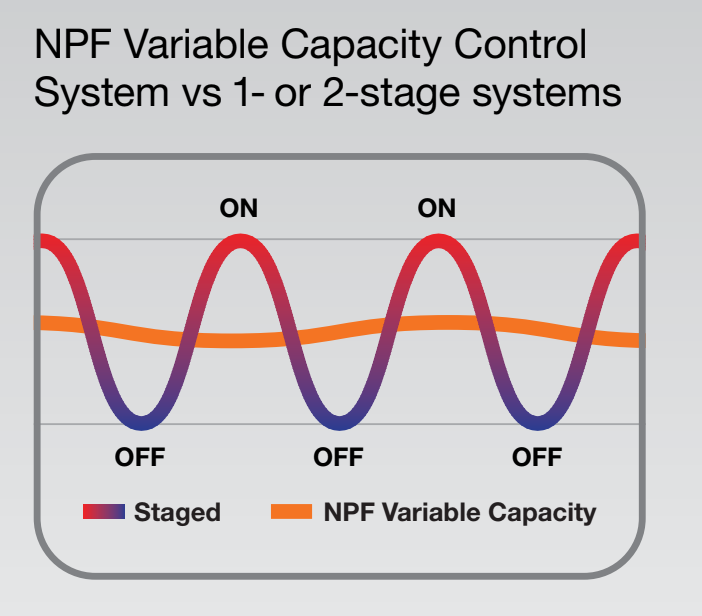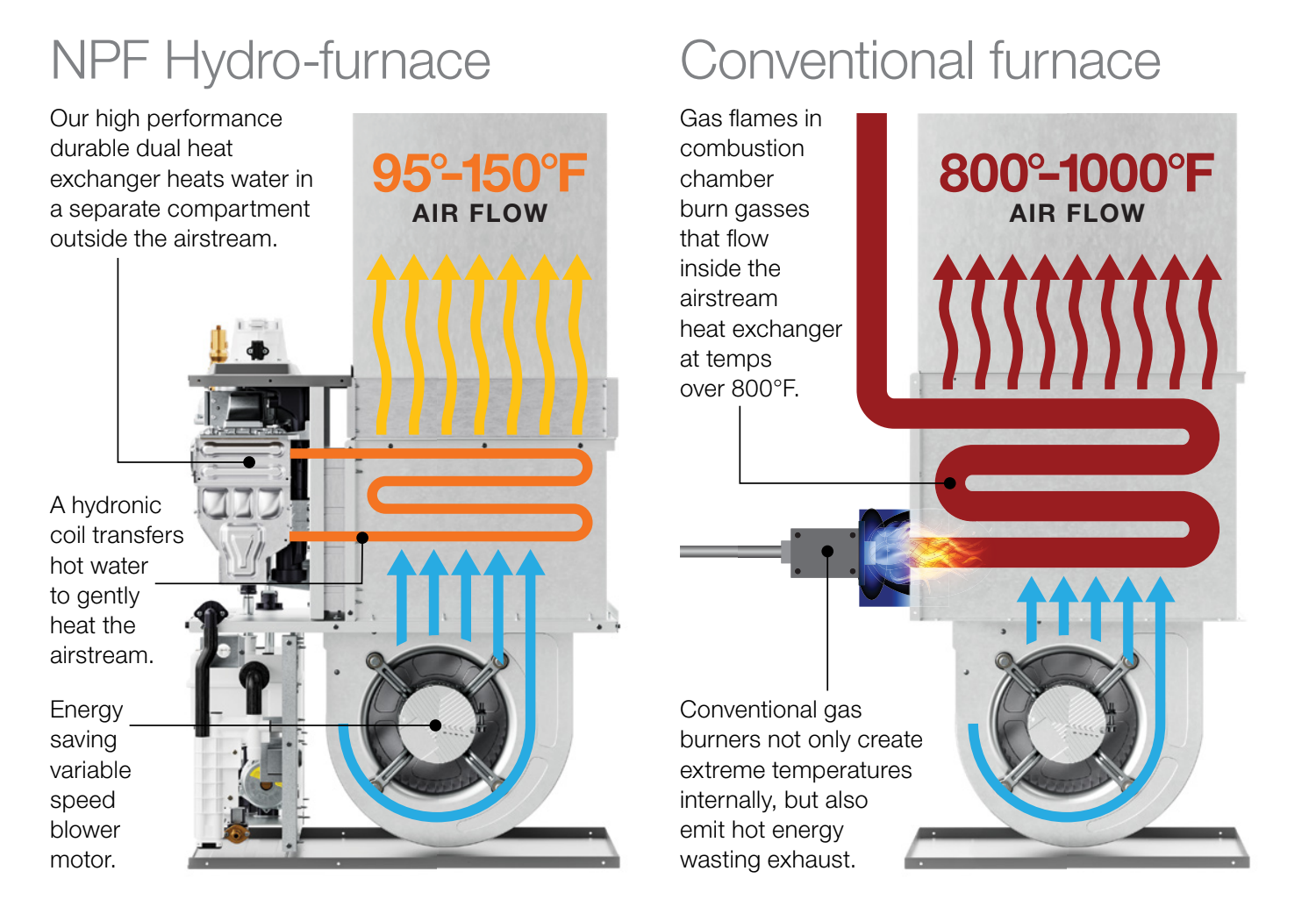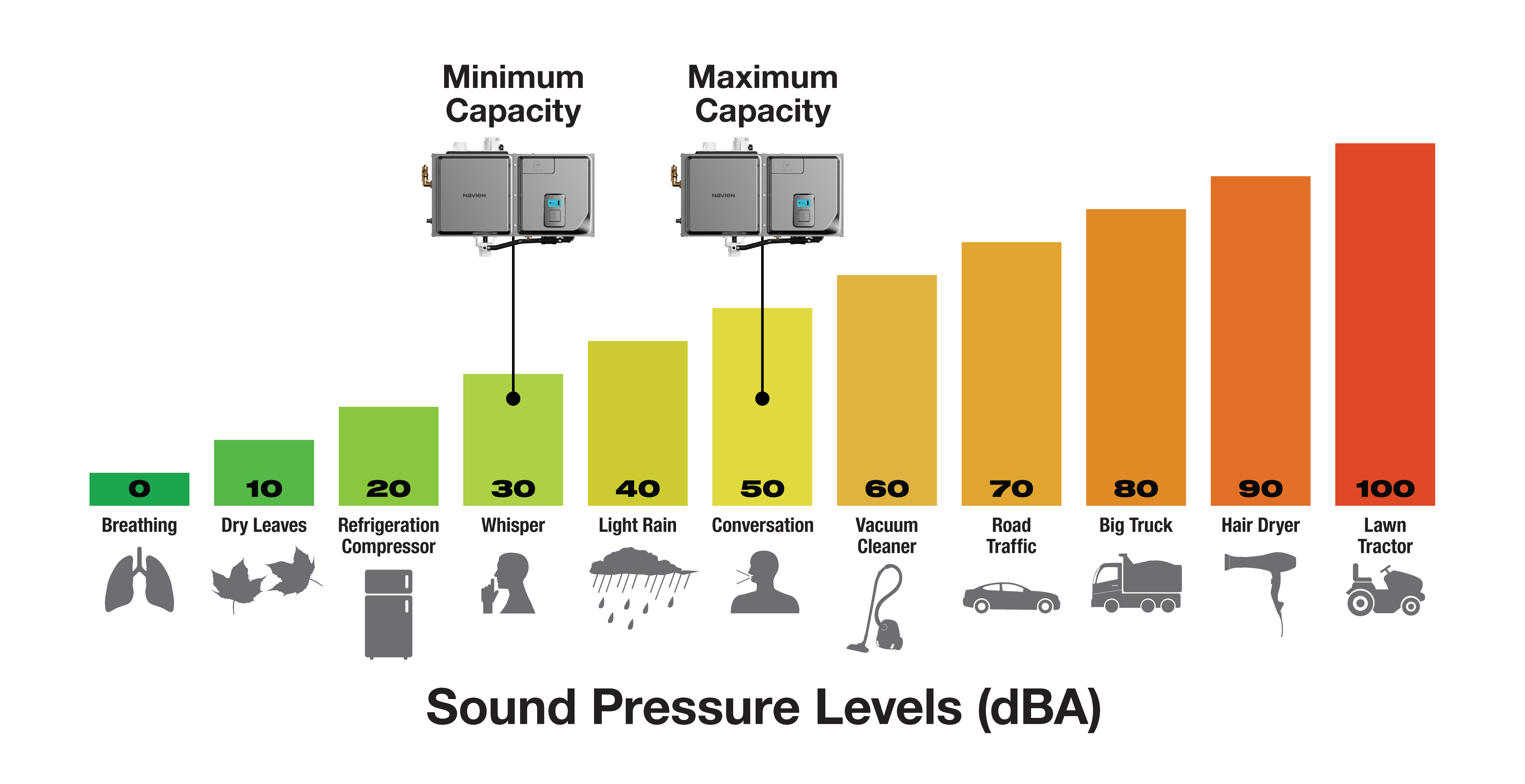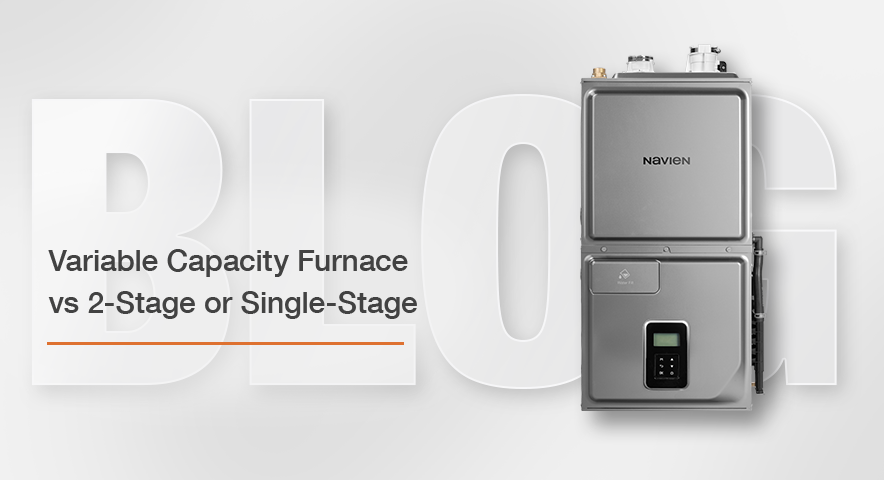Variable capacity, two-stage and single-stage gas furnaces all use a blower motor to move heated air through your home. But each furnace type has different blower speed control capability, which affects energy efficiency and comfort.
How furnace stages and blower speeds work:
- Single-stage furnaces have a blower motor with one setting: full blast. Anytime the thermostat calls for heat, the furnace runs at 100% capacity until the target temperature is reached. It's simple but not very efficient, and doesn’t maintain a steady indoor temperature as well as other types.
- Two-stage furnaces (also called multi-stage) have a blower motor and heat exchanger with two settings: low and high. This improves efficiency and comfort compared to a single-stage.
- Variable Capacity furnaces (also called modulating ) have a more advanced heat exchanger design and blower system that will continuously adjust the blower speed and heating capacity in small increments, for more precise heat output and more even temperatures in a home. They are more energy efficient, quieter, and better at maintaining your desired temperature than single or two-stage furnaces.
Navien’s NPF Hydro-furnace will automatically adjust from 15% capacity up to 100%, to precisely match your home’s comfort needs moment by moment.

Which furnace type should you get for your home?
If you want consistent comfort, lower energy bills, and a system that adapts to your home’s year-round heating and cooling needs, then a variable-capacity furnace has clear, long-term advantages over single- and two-stage systems.
Consider your home size, climate, and long-term priorities:
| Furnace Type | Comfort | Humidity Control | Sound | Upfront Cost | Long-Term Savings |
| Single-stage | Low | None | High | Low | Low |
| Two-stage | Medium | Limited | Medium | Medium | Medium |
| Variable Capacity (NPF) | Excellent | Excellent | Very Low | Higher | Highest |
- Single-stage: Basic, lower-cost option best suited for small spaces or mild climates that require occasional heating.
- Two-stage: A step up from a single-stage furnace in terms of both cost and performance.
- Variable Capacity: Best choice for homeowners who want to maximize comfort, energy savings, and long-term value. Especially well-suited to larger homes, variable climates, and multi-story layouts.
Why furnace speed matters for efficiency
Running a furnace full blast wastes energy. Single-stage systems cycle on and off frequently, which uses more gas and electricity. Two-stage models help reduce some of that waste, because they have the ability to run at a lower setting.
Variable-speed furnaces are designed for optimal efficiency, and use less gas and electricity overall. They’re able to adjust the blower motor speed to deliver just the right amount of airflow to maintain comfort.
Learn more about high efficiency furnaces work, including AFUE, lifespan, rebates, and more.
How variable Capacity, two-stage or single-stage affects comfort
Variable capacity furnaces outperform both two-stage and single-stage furnaces by providing more consistent, even heating throughout your home.
Single-stage: better than nothing
Single-stage furnaces can only cycle on or off, making it harder to maintain a steady temperature. Not only are temperature swings more noticeable, heating can be uneven. Areas closest to vents heat up quickly, but the furnace often shuts off before heat fully circulates through the home, so areas farther from vents can be less comfortable.
Two-stage: good, but not great
With low and high speed options to meet heat demand, two-stage furnaces can run for longer at the lower setting. This makes them better at maintaining a steady indoor temperature, and reducing cold spots.
Variable speed: king of comfort
Variable capacity furnaces make incremental, real-time heat and airflow adjustments to keep your indoor temperature steady, even as conditions outdoors change. The constant, gentle airflow prevents cold spots and temperature swings. In contrast, single and two-stage furnaces can’t adjust heating and airflow with precision when temperatures fluctuate.
The NPF’s variable capacity control system adapts to shifting weather for stable comfort year-round, even providing independent airflow for your heat pump or air conditioner in summer.
With NPF, even the air feels more comfortable
Conventional single- and two-stage furnaces burn gas in a heat exchanger located directly in the airstream, subjecting the air to high temperatures that can deplete humidity levels.
Navien’s variable Capacity NPF Hydro-furnace heats water in a heat exchanger located out of the airstream first, then uses the hot water to gently warm the air at much lower temperatures, for minimal impact on humidity levels.

Are variable-speed furnaces quieter than two-stage?
Yes! Because variable-speed systems often run at very low capacity, they make much less sound than single- or two-stage models. The NPF Hydro-furnace operates as low as 30 dBA — about the level of a whisper.

Is it worth getting a variable-capacity furnace?
For most homeowners planning to stay in their home long-term, the extra upfront cost of a variable-capacity furnace is often offset by years of lower energy bills, better comfort, and potentially longer system lifespan. Learn more about the advantages of variable capacity furnaces.
You don’t need to be an HVAC expert to see the value
Driving in traffic is a good analogy for comparing furnace types:
Single-stage furnace: like driving a car that can only go full speed or stand still. Every time traffic moves, you slam on the gas to full speed, then slam the brakes when you have to stop. All that sudden starting and stopping burns a lot of gas and isn't very efficient. It’s also hard on the brakes and engine, and uncomfortable for passengers.
Two-stage furnace: like driving a car with two speeds: full speed or moderate cruising. You still have to start and stop, but you’re not slamming on the gas and brakes as much. It’s more efficient, less uncomfortable, and doesn’t wear out your brakes as fast—but it’s still not ideal.
Variable-capacity furnace: like driving a car with a smooth, continuously adjustable gas pedal. You can gently speed up or slow down as needed to match the flow of traffic, using just the right amount of fuel. This smooth, steady operation burns less gas, offers a more comfortable ride, and reduces wear and tear.
Furnace type FAQ
Is a variable capacity furnace better than a two-stage furnace?
Yes. Variable capacity furnaces offer more precise heat and airflow control, steadier temperatures, quieter operation, and better energy efficiency than two-stage models.
What are the disadvantages of a single-stage furnace?
Drawbacks of a single-stage furnace include higher energy use, noticeable temperature swings, more frequent cycling on/off, and less consistent comfort compared to multi-stage or variable capacity systems.
What are the disadvantages of a two-stage furnace?
While better than single-stage, two-stage furnaces still have limited capacity settings. They don’t optimize comfort and energy use as effectively as a variable capacity furnaces can.
Learn more about how Navien’s innovative variable capacity forced-air heating system delivers industry-leading variable capacity operation for unparalleled efficiency and comfort.
